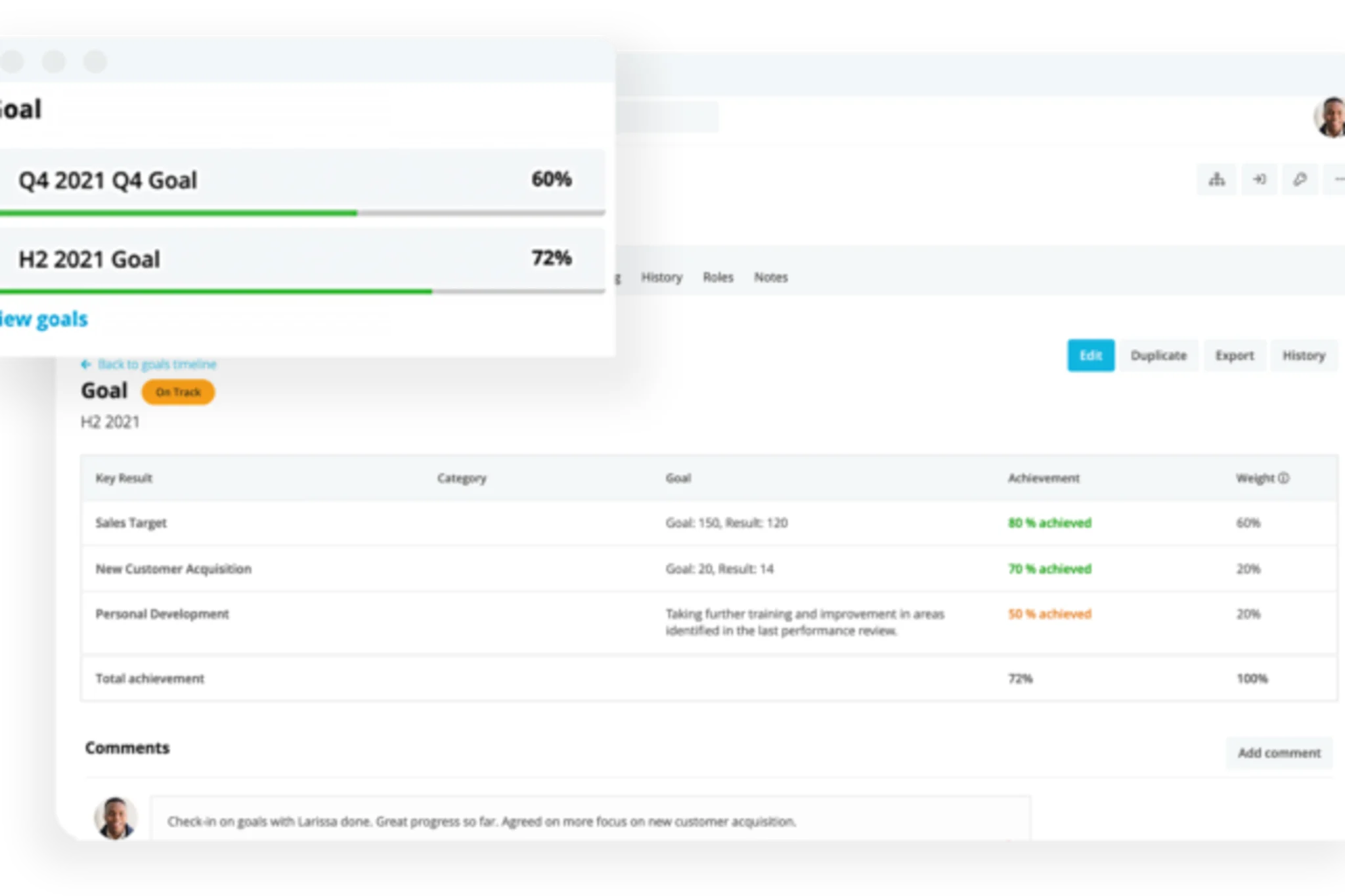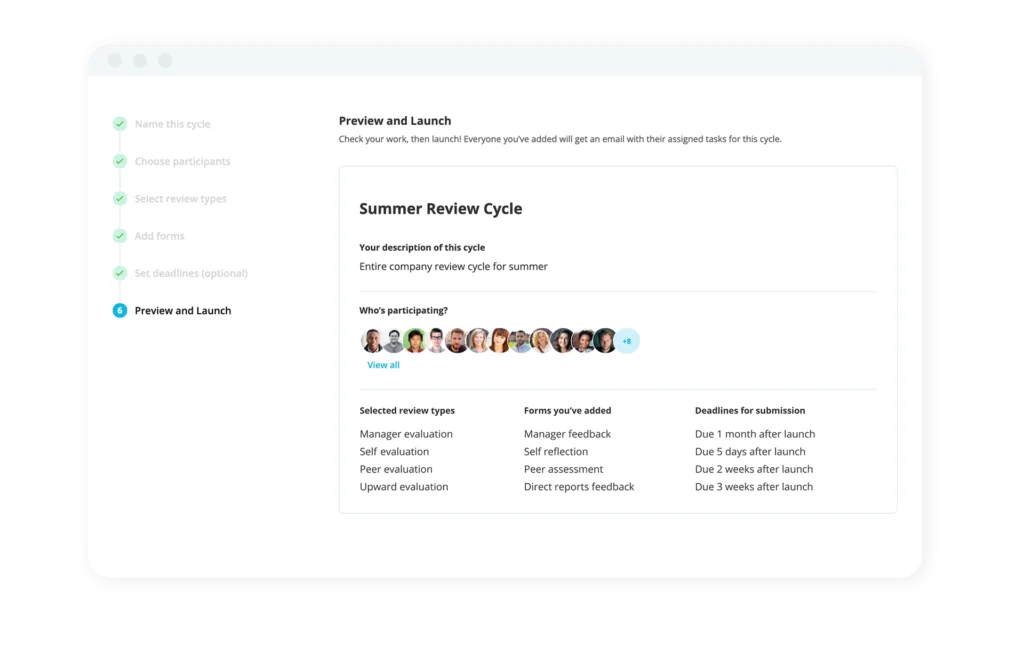The 9 Critical Leadership Behaviours For Amazing Organisations

Great leaders lead people to success, and cultivating good leadership behaviours can play a pivotal role in inspiring, commanding respect and driving business success higher.
Why? Because it doesn’t just help your leaders, it helps the whole company. In this post, we’re breaking down what makes for a great leader and how to encourage the right kinds of leadership behaviours in your organisation today.
Download our guide to Performance Management today.What Are Leadership Behaviours?
Leadership behaviours are the combination of specific characteristics that leaders have and the actions they take. Strong leadership behaviours make someone an effective leader. Negative leadership behaviours can undermine their credibility and make them less convincing, effective and inspiring.
Why Are Good Leadership Behaviours Important?
To answer this question, it’s important to address the difference between leadership and management.
Management could be defined as the skill of directing, controlling, handling, deciding or overseeing employees and their actions. Leadership, on the other hand, is about influencing, developing, coaching, guiding and inspiring others.
Leaders are often managers, but it is possible to be a leader without ever having a direct report.
It is possible to teach good management skills – they help organisations function smoothly. But teaching, or instilling, good leadership behaviours is about more than just getting a job done. It helps people feel like what they’re doing is important. It helps them feel inspired, motivated, driven and – hopefully – even proud of the job they do.
How Do Leadership Behaviours Relate to Company Culture?
Good leadership behaviours help support an organisation’s corporate culture.
When people are respected, well-led and supported (in line with the nine leadership behaviours for success we discuss below), the whole company benefits.
Productivity improves, people work better under pressure, employee turnover reduces, stress can decrease, relationships are stronger, teams communicate well, problems don’t seem as insurmountable, team members support one another and people can make better decisions because they’re focused on heading in the same direction.
Are Leadership Behaviours Innate, Or Can They Be Taught?
Some people believe that leaders are born and not made. If you’ve ever been inspired by someone who has an indefinable spark that makes them compelling, you’ll know you’ve been in the presence of an innate leader. But that doesn’t mean all leaders are inspirational, or good leadership behaviours can’t be taught. They can.
How Do Leadership Behaviours Relate To Employee Performance?
The strength of a team, its ability to perform, its cohesiveness and its effectiveness depend on its leader to a large extent. A weak or divisive leader may try to keep control by bullying, belittling or dividing his or her team members or creating a toxic work environment. But when teams are led by people with good leadership behaviours, more often than not, they thrive.
Take a look at these examples of what happens to employee performance when good leadership behaviours are common:
Good leadership behaviours and common employee responses
If a leader… | Team members… |
|---|---|
Listens well | Are more honest |
Asks questions with genuine interest | Are willing to reveal what the real issue is |
Includes people | Share more |
Inspires people | Come up with more ideas |
Embraces diversity | Think holistically |
All of these examples can lead to productivity improvements by helping people feel valued and safe and reinforcing a company’s psychological contract.
Positive leadership behaviours can improve employee motivation, reduce absenteeism and staff attrition and even reduce the chances of employee burnout.
On the other hand, the following table shares a few examples of what happens when negative leadership behaviours are used.
Destructive leadership behaviours and common employee responses
If a leader… | Team members… |
|---|---|
Shouts people down | Feel afraid, shut up and stop being innovative |
Bullies people | Assign blame to others |
Sets unrealistic deadlines | Work to a point of exhaustion, or give up |
9 Key Leadership Behaviours For Business Success
While leadership and management are different, many good management practices also apply to great leadership. For example, different management styles can affect the way both managers and leaders are perceived. After all, there’s a huge difference between an autocratic and a transformational leader.
Good people management skills – including having a clear vision, communicating effectively and trusting, and being trustworthy – also overlap with a lot of leadership behaviours.
We’ve assessed current leadership thinking to bring together these nine leadership behaviours which, when used consistently and effectively, are likely to enhance business success
1. Emotion & Empathy
Great leaders are approachable and compassionate: within limits. They know when to care about employees and when to draw the line between being caring and practising tough love.
Great leaders can practice proactive empathy. They show understanding, and care: but being empathetic doesn’t mean they let themselves be taken advantage of.
Another great leadership behaviour is being able to coach people to become better versions of themselves (dive deeper: The Grow Coaching Model). This requires empathy. When it’s combined with good communication skills and appropriate support it brings enormous benefit to both individuals and the company.
2. Appropriate Support
One great leadership behaviour is to be able to advise and support team members: then get out the way! Great leaders know that when they enable their team to make informed decisions they build their confidence, independence, autonomy and leadership potential.
But leaders are also adaptable. They know that things go wrong, and are willing and able to make change happen when it needs to.
3. Firmness (with Fairness)
Another great leadership behaviour is being able to accept mistakes, fix problems and move on from mistakes by learning from what went wrong and not dwelling in the past.
Great leaders can balance the ability to understand and accept mistakes while drawing a firm line between acceptable and unacceptable behaviour, using the company’s corporate culture and core values as guidelines.
4. Attentiveness
Great leaders pay attention to what people are saying and what they’re not saying. They also pay attention to what their employees need, what they’re asking for, and what the real issues are. Then they provide appropriate support fairly, but firmly.
5. Communication
No article on leadership behaviours would be complete without addressing the key issue of communication.
It is one of the most important elements of good management and good leadership. Leaders who can keep the lines of communication open, be honest and direct (without being hurtful), give good feedback and listen effectively are 90% of the way to successful leadership.
6. Direction & Adaptability
The ability to build a vision is an essential leadership behaviour. The vision may not necessarily be the leader’s – but they have to be able to help people see why it’s important, how it serves a purpose, and why their contribution is critical.
Then, it’s important to provide the resources and support to help them get there.
Another positive leadership behaviour is being able to make confident decisions and stick with them, whilst being adaptable enough to change direction when necessary and admit that they’re not always right.
7. Conflict Resolution
Leading people can often involve dealing with conflict management. However, although conflict is challenging, it doesn’t always have to be detrimental. Conflict can be dealt with in positive ways. With open debate and discussion, healthy conflict can actually improve products, resolve issues and help teams strive to do what’s right (even if it’s not easy).
8. Consistency
While it may not seem the most obvious leadership behaviour, being able to practice what they preach (lead by example) is key to gaining the workforce’s trust. Great leaders also actively work to improve their own leadership style by learning, developing and growing. And they know how to access and use their company’s learning and development (L&D) resources.
9. Gratitude & Praise
Lastly, great leaders understand the importance of giving rewards and recognition, showing gratitude, and enabling people to do what they do best by providing the best resources they can. In short: great leaders give the credit and take away the pain.
How Do You Encourage Good Leadership Behaviours?
Even the best set of leadership behaviours is a goal, not necessarily a reality. Leaders are humans. We all make mistakes. But we can learn.
That’s why learning and development is so important. It helps evolve and improve leadership behaviours while supporting employees and improving organisational resilience as a whole. It’s also why 360 degree feedback is so useful: to help improve leadership behaviours, especially when leaders need a bit of help to become aware of areas where they can improve.
How Can HR Software Help Support Your Organization’s Leaders?
By now it should be clear that leadership behaviours can be learned. So how can HR software help? Firstly, HR software can ensure performance management cycles are automated.
As a result, it’s much easier to execute performance reviews without a hitch. Furthermore, by helping employees self-reflect in a secure and honest way, and by helping in establishing and encouraging goal creation, progress and completion, HR software helps leaders learn and improve.
Leadership isn’t always easy. But a great leader knows when they need support. Automated HR software is an easy-to-use, user-friendly piece of support that lets them do what they do best: lead and inspire their teams and companies to do extraordinary things.


